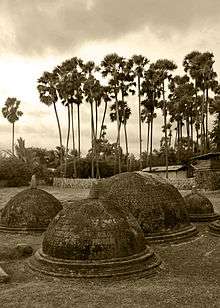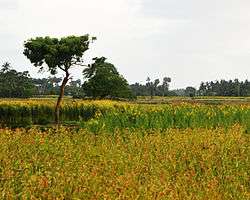Kandarodai
Kandarodai (Tamil: கந்தரோடை, translit. Kantarōṭai, Sinhalese: කදුරුගොඩ, translit. Kadurugoḍa, also known as Tamil: கதிரமலை, translit. Katiramalai) is a small hamlet and archaeological site of Chunnakam town, a suburb in Jaffna District, Sri Lanka.
Known as Kadiramalai in the ancient period, the area served as a famous emporium city and capital of Tamil kingdoms in the Jaffna peninsula of North Eastern Ceylon from classical antiquity.[1] The notable ancient buddhist monastery referred as Kadurugoda Vihara is situated in Kandarodai.[2]
Located near a world-famous port at that time, Kandarodai was the first site the Archaeology Department in Sri Lanka excavated in the Jaffna peninsula.[3]
Etymology
This place was initially known as Kadiramalai.[4] According to C. Rasanayagam is the Sinhalese name Kadurugoḍa derived from Kadiragoda, which is according to him derived from Kadiramalai, substituting the Tamil suffix malai (meaning "mountain") with the Sinhalese suffix goḍa (meaning "unleaded ground"). The prefix Kadira is the Tamil name for the Acacia chundra three.[4] The modern Tamil name Kantarōṭai is believed to be re-derived from the Kadiragoda term.[5]
The name Kadurogoda viharaya is mentioned in the 15th century Sinhalese text Nampota.[6][7] Some schools holds that Kadurugoda is derived from the Sinhalese name Kandavurugoda (a site of a military encampment).[8] The Portuguese archives refer to this place as Kandarcudde.[9]
History
Black and red ware Kanterodai potsherd Tamil Brahmi scripts from 300 BCE excavated with Roman coins, early Pandyan coins, early Chera Dynasty coins from the emporium Karur punch-marked with images of the Hindu Goddess Lakshmi from 500 BCE, punch-marked coins called Puranas from 6th-5th century BCE India, and copper kohl sticks similar to those used by the Egyptians found in Uchhapannai, Kandarodai indicate active transoceanic maritime trade between ancient Jaffna Tamils and other continental kingdoms in the prehistoric period.[10][11]
The parallel third century BCE discoveries of Maanthai, Anaikoddai and Vallipuram detail the arrival of a megalithic culture in Jaffna long before the Buddhist-Christian era and the emergence of rudimentary settlements that continued into early historic times marked by urbanization.[12] Some scholars have identified Kourola mentioned by 2nd century AD Greek geographer Ptolemy and Kamara mentioned by the 1st century AD Periplus of the Erythraean Sea as being Kadiramalai.[13]
The earliest people of Jaffna were belonging to a megalithic culture akin to the South Indian megalithic culture. The period of buddhism in the Jaffna Peninsula differ from the rest of the island, which is seen as an overlapping of the megalithic beliefs with buddhism.[14] The ancient Kadurugoda Vihara buddhist monastery is situated at this site.[2] Kandarodai was a buddhist mercantile centre among Tamils.[15]
Recent excavations of Sivaganams in the stupas suggest Tamil Hindus also worshipped at the site. The domes were reconstructed atop the flat bases of the ruins by the Archaeology Department. The similarities between the finds of ancient Jaffna and Tamil Nadu are indicators of a continuous cultural exchange between the two regions from classical antiquity.[16] These structures built over burials demonstrate the integration of Buddhism with Megalithism, a hallmark of Tamil Buddhism. Outside Andhra Pradesh in India, Kanterodai is perhaps the only site where such burials are seen.
According to scholars was Kantarodai, known in Tamil literature as Kadiramalai, the capital of the ancient Tamil Kingdom ruled by Tamil speaking Naga kings from 7th century AD to 10th century AD.[1] The Yalpana Vaipava Malai also describes Kadiramalai as the seat of Ugrasinghan who fell in love with a Chola princess in the ancient period.[17]
In 1970, the University of Pennsylvania museum team excavated a ceramic sequence remarkably similar to that of Arikamedu, with a Pre-rouletted ware period, subdivided into an earlier "Megalithic", a later "Pre-rouletted ware phase," followed by a "Rouletted ware period". Tentatively assigned to the fourth century BCE, radio carbon dating later confirmed an outer date of the ceramics and Megalithic cultural commencement in Kandarodai to 1300 BCE.[18] Further excavations have been conducted by the University of Jaffna.
Gallery


See also
Notes
References
- 1 2 Arunthavarajah, K. (2014). "The Views of Tamil Scholars Regarding the Origin of Jaffna Kingdom". Research on Humanities and Social Sciences. Department of History, University of Jaffna. 4 (10): 110. ISSN 2225-0484 – via IISTE.
- 1 2 Archaeological Department Centenary (1890-1990): History of the Department of Archaeology. Commissioner of Archaeology. 1990. p. 175.
- ↑ Wijesekera, Nandadeva (1990). Archaeological Department Centenary (1890-1990): History of the Department of Archaeology. Commissioner of Archaeology. p. 175.
- 1 2 Asia, International Association of Historians of (1988). Eleventh IAHA Conference: International Association of Historians of Asia, Colombo, 1-5 August 1988. The Association. p. 46.
- ↑ Asia, International Association of Historians of (1988). Eleventh IAHA Conference: International Association of Historians of Asia, Colombo, 1-5 August 1988. The Association. p. 45.
- ↑ Paul E. Pieris (1917). Nagadeepa and Buddhist remains in Jaffan. Journal of the Ceylon branch of the Royal Asiatic society. p. 13.
- ↑ C.E. Godakumbura (1968). Kandarodai. Journal of the Ceylon branch of the Royal Asiatic society. p. 70.
- ↑ Wijebandara, I.D.M. (2014). Yapanaye Aithihasika Urumaya (Historic Legacy of Jaffna) (in Sinhala). p. 93. ISBN 978-955-9159-95-7.
Sinhalese: කදුරුගොඩ යන නාම සම්භවය ගැන සදහන් වන තැන කඳුරුගොඩ යන්න පැරණි සිංහල වචනයක් වන කඳවුරුගොඩ යන්නෙන් බිඳී අැත. (එය හමුදාමය කටයුතු සඳහා භාවිත භූමියකි.) මෙම කඳවුරුගොඩ කඳුරුගොඩ වූ අතර එහි ද්රවිඩ රූපය කන්දරෝඩෙයි විය.
English: Where the etymology of Kadurugoda is mentioned, Kadurugoda has been broken from old Sinhalese word Kandavurugoda (It is a land used for military purposes). This Kandavurugoda became Kadurugoda and it's Tamilised (or Dravida) form was Kandarodai) - ↑ Rasanayagam, C.; Rasanayagam, Mudaliyar C. (1993). Ancient Jaffna: Being a Research Into the History of Jaffna from Very Early Times to the Portuguese Period. Asian Educational Services. p. 59. ISBN 9788120602106.
- ↑ Intirapālā, Kārttikēcu (2005). The evolution of an ethnic identity: the Tamils in Sri Lanka c. 300 BCE to c. 1200 CE. M.V. Publications for the South Asian Studies Centre, Sydney. p. 63. ISBN 9780646425467.
- ↑ International Journal of Dravidian Linguistics. Department of Linguistics, University of Kerala. 2009. p. 62.
- ↑ S. Krishnarajah (2004). University of Jaffna
- ↑ Rásanáyagam, C.; Gunasekara, A. Mendis (1922). "THE TAMIL KINGDOM OF JAFFNA AND THE EARLY GREEK WRITERS". The Journal of the Ceylon Branch of the Royal Asiatic Society of Great Britain & Ireland. 29 (75): 46. JSTOR 43483754.
- ↑ Ragupathy, Ponnampalam (1987). Early Settlements in Jaffna: An Archaeological Survey. Thillimalar Ragupathy. p. 183.
- ↑ Schalk, Peter; Veluppillai, A.; Nākacāmi, Irāmaccantiran̲ (2002). Buddhism among Tamils in pre-colonial Tamilakam and Īlam: Prologue. The Pre-Pallava and the Pallava period. Almqvist & Wiksell. p. 94. ISBN 9789155453572.
- ↑ Man and environment (2002). Indian Society for Prehistoric and Quaternary Studies. Volume 27, Issue 2. pp. 27
- ↑ Pillay, Kolappa Pillay Kanakasabhapathi (1963). South India and Ceylon. University of Madras. p. 117.
- ↑ (Begley,V. 1973)
| Wikimedia Commons has media related to Kandarodai. |